Visit Library for MBP Pro eBooks |
We pick up the trail in this fifth and final part of my Complete Namibia Tour report for 2022 as we made our way into the Etosha National Park on a day that we’d traverse the entire park from West to East, and shortly after entering the park we noticed this Spotted Hyaena having a morning stroll. It was difficult to catch him as he walked quickly through the park behind the trees, but I managed to grab a frame or two when he was in a good clearing. The sun was behind him, so the lighting not great, but the shadows slider in Capture One Pro helped me to bring out a lot of detail in the Hyaena, so I’m pretty happy with this.
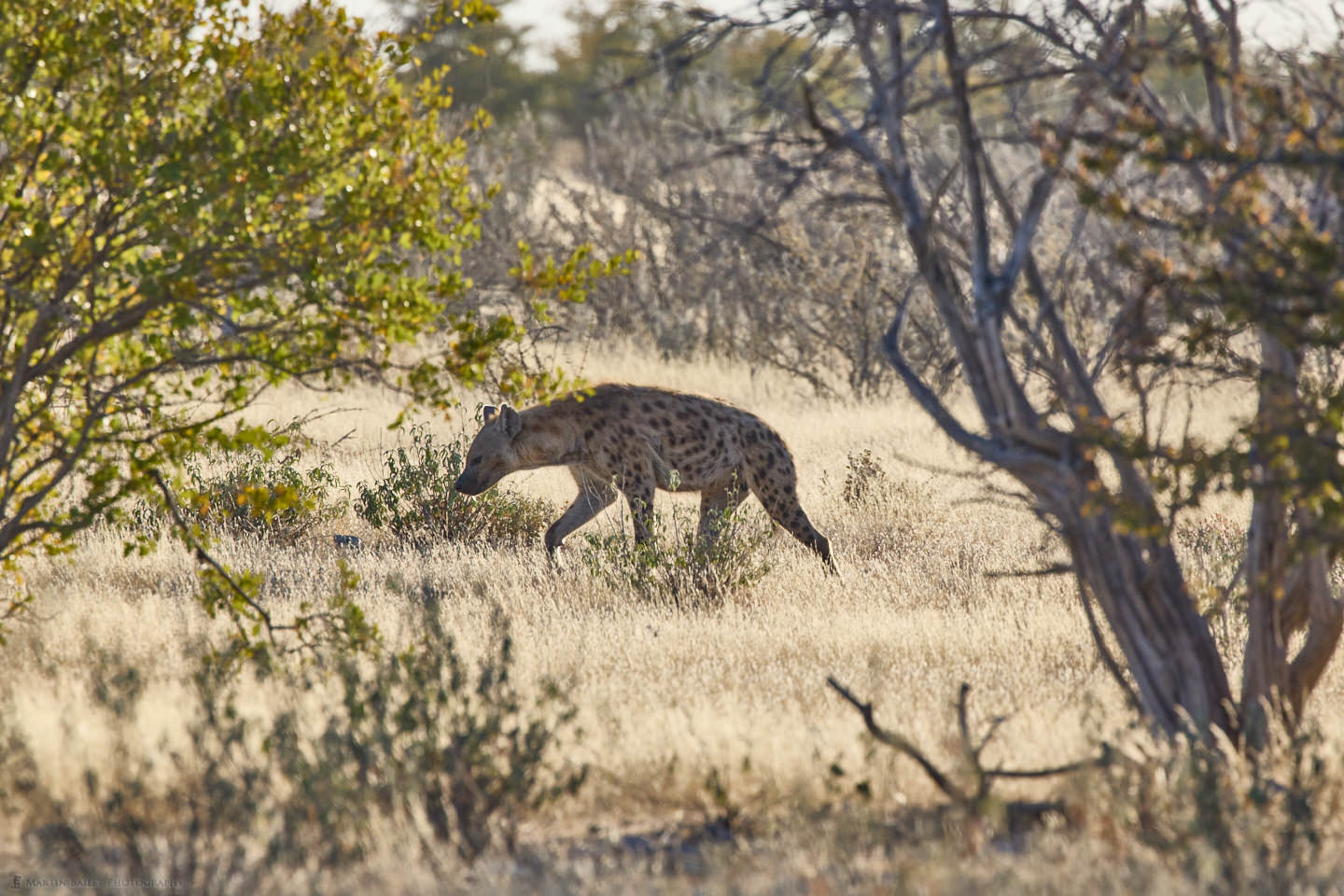
A large part of what I teach on my workshops is the importance of keeping your eye on your exposure via the histogram, and this shot shows the importance of that better than most. I almost always expose to the right, which means that I am manually changing my exposure so that the brightest part of the image, represented by the right-most data on the histogram, always falls just before or even just touching the right shoulder of the histogram frame. For many reasons, this will generally give you the best image quality, but in this image, it was key to gaining a well exposed image while giving me enough information in the hyaena to bring out the shadow details.
If I had left it up to the camera, the scene would have been recorded in the middle of the histogram, and the hyaena would have been so dark that the details would not have been recoverable from the shadows. Even as I shot this at my adjusted exposure, the hyaena was almost completely black, in silhouette, but I trusted my process and got a shot I’m happy with.
Shortly after our encounter with the hyaena, we headed to a waterhole where we found some zebra taking a drink, and they had pretty nice reflections, resulting in this image. Zebra are always great subjects, but those dazzling stripes getting doubled up in the reflections make for a striking image, and the sun caught some of their eyes, giving me some lovely catchlights.
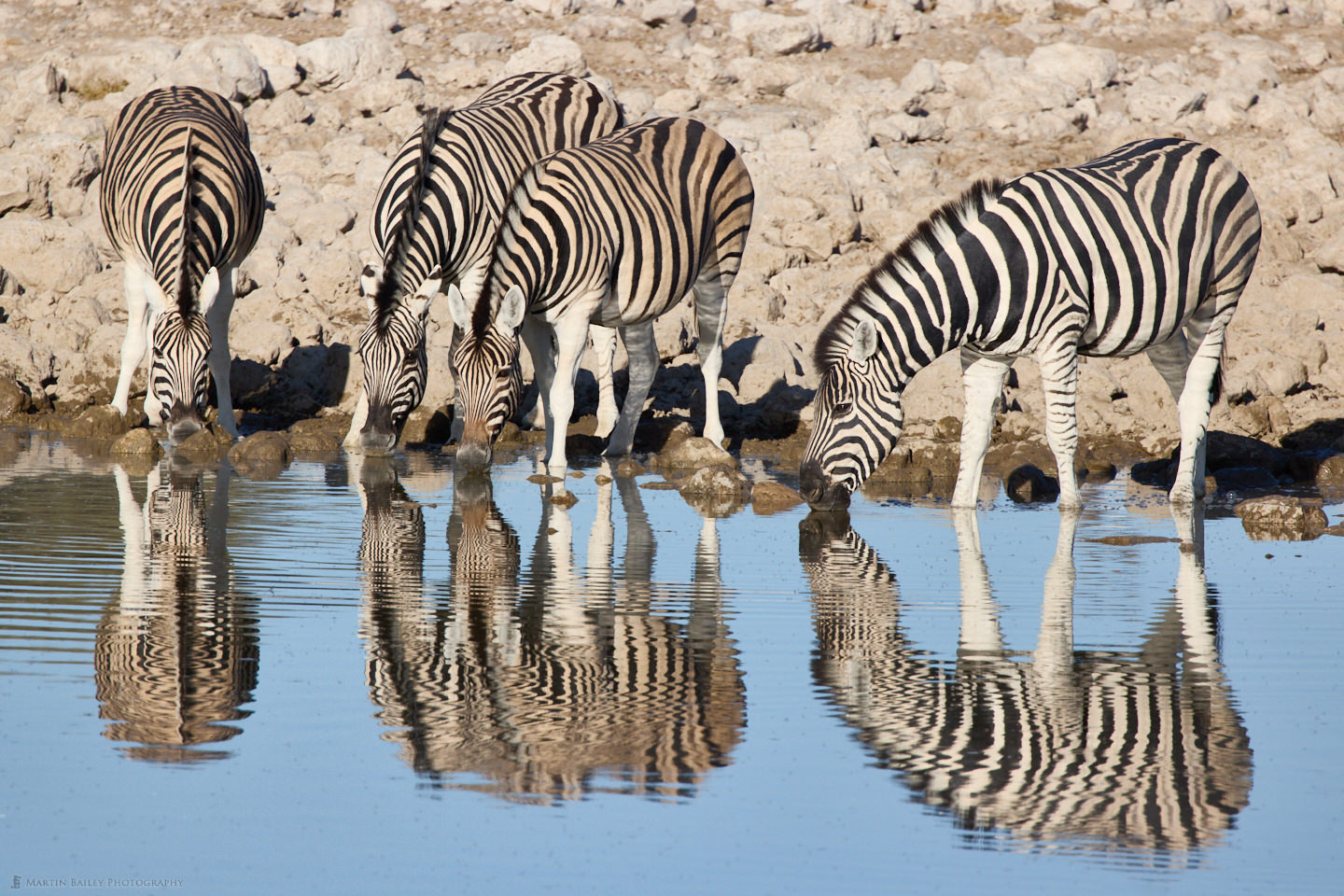
The following image is a little bitter-sweet for several reasons. At first, I was really happy to find a leopard out in the open. Until now, I’ve only seen leopards in Namibia obscured by thickets or foliage or for just a few seconds before they took cover again. This leopard was sitting under a tree with what we thought was probably a springbok he’d taken down. The first problem with this, though, was that it was the middle of the day, and he was very far away. That means that even though I could use a 2X extender on my RF 100-500mm lens for a focal length of 1000 millimeters, the shimmering of the air from the heat takes away most of the clarity in the subject. It looks OK-ish when you view the full-frame image, but when you zoom in on the leopard, the image quality just isn’t there.
The second problem you may just be able to make out is that this animal has the wire of a snare wrapped tightly around its upper jaw. You might be able to see that the skin on the snout is pinched downwards between the nose and the eye, and also, the upper lip is pulled up a centimeter or so. Although the leopard was trying to eat, I guess that the snare was so uncomfortable or painful that he was having trouble making a start on his meal. As soon as I returned to Tokyo a few days after this, I sent this photo with GPS coordinates and the name of the nearby waterhole to our travel partner for this tour, and they, in turn, passed this information on to one of the vets that work in the Etosha National Park, so that they could locate, anesthetize and then take the snare off of this beautiful animal. I haven’t heard anything back yet, but hopefully, it won’t take long before we can remove that snare and give this guy a normal life again.
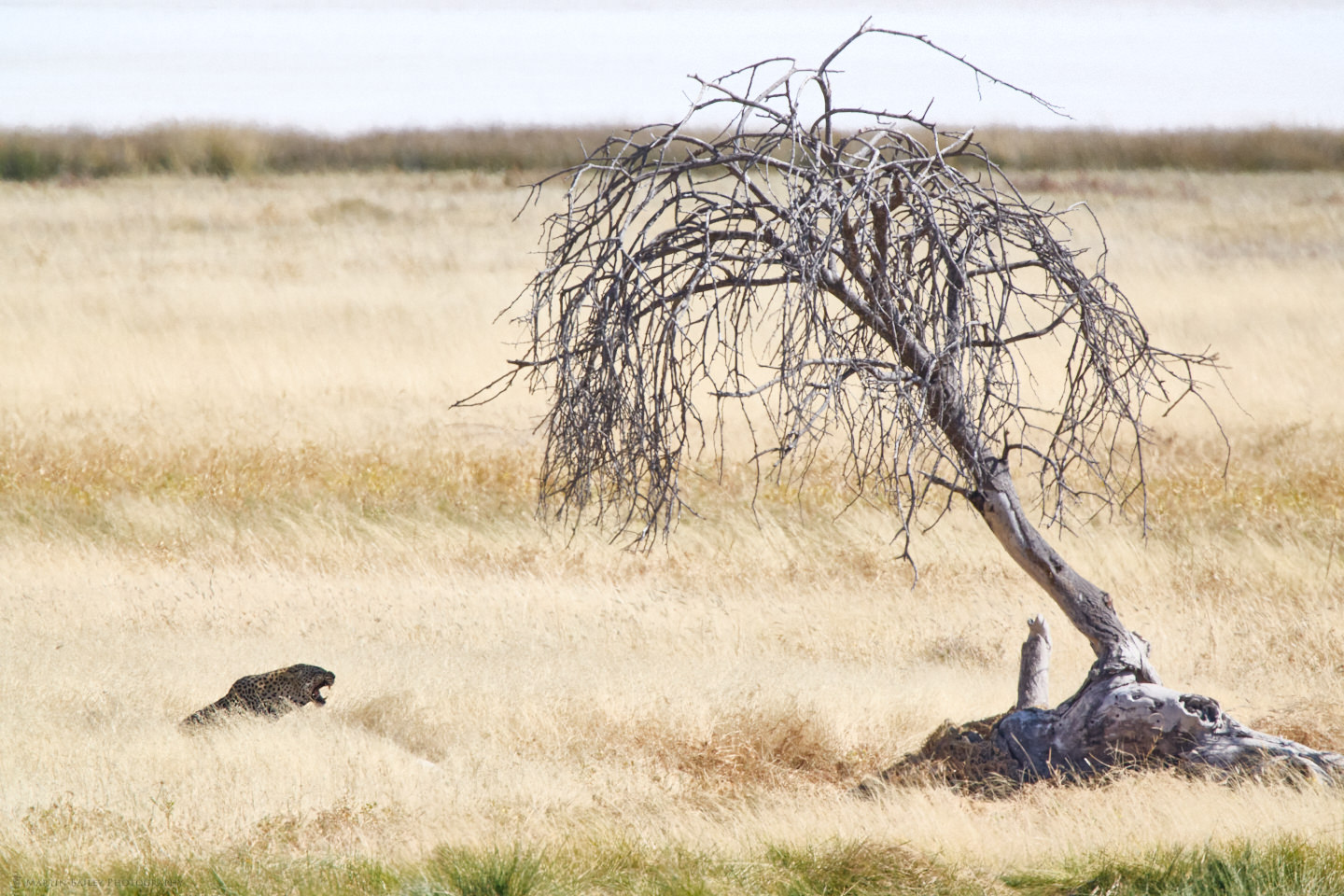
I should add that I was not aware of the snare when I shot this image. I was trying to make the best of the situation, using the tree to augment the landscape and show the leopard in its environment. I only saw the snare later when I zoomed in to check the lack of detail in the leopard.
Many years ago I photographed a Secretary Bird at the Ueno Zoo here in Tokyo and was amazed at how beautiful it was, with its long eyelashes and pristine headdress. I was still working in my old day job and honestly didn’t, at the time, even dream that my efforts as a podcaster and blogger would lead me to become an international tour and workshop leader, so this next photo has a special place in my heart. We came across a Secretary Bird in the wild, strutting through the grasses in the Etosha National Park. At first, it was far away, and the clarity was low due to the mid-day heat haze. This time, our subject continued walking towards us, so I was able to get this beautifully clear shot at 500mm as the bird continued walking, looking for lizards and other small animals, even snakes, to prey upon.
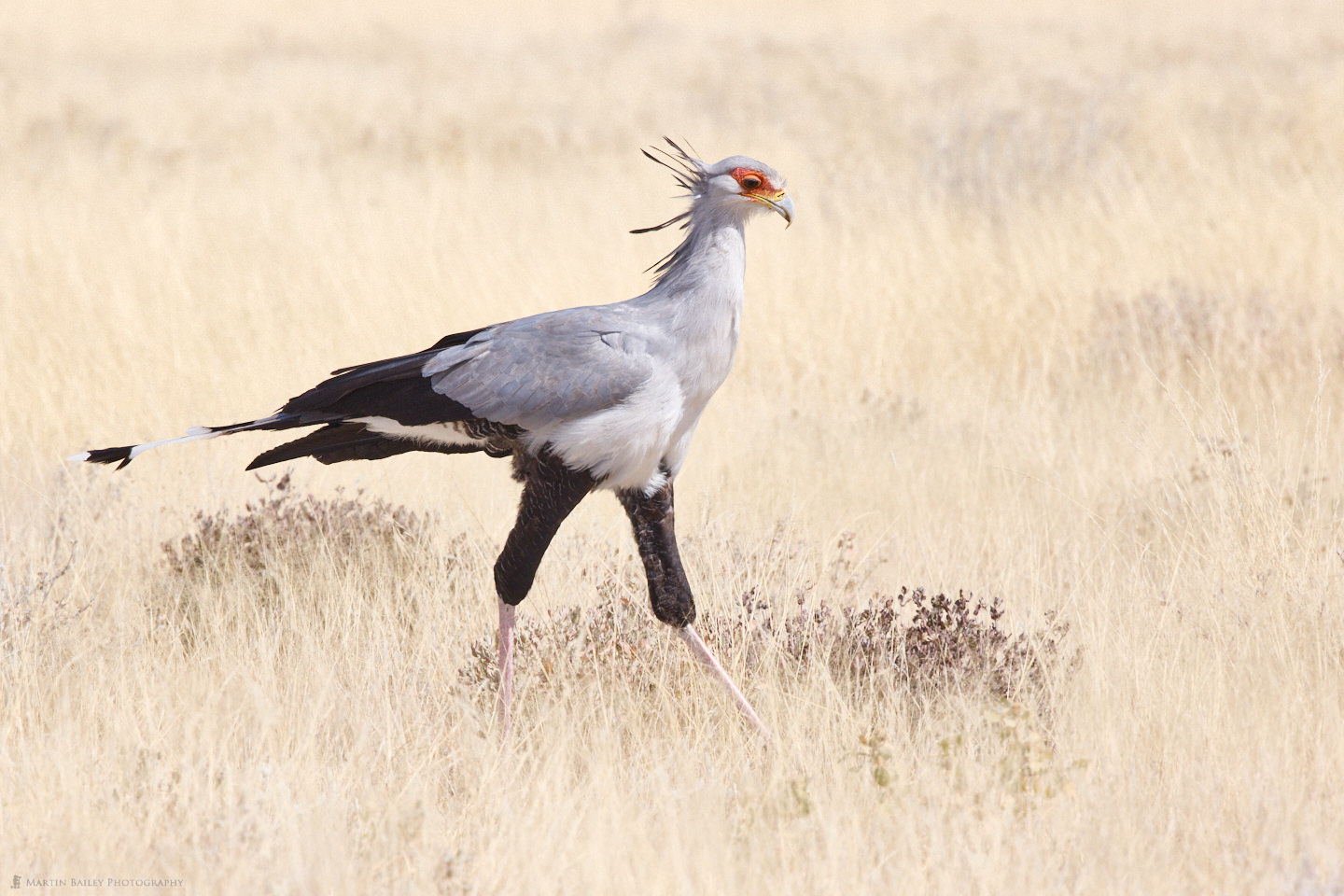
These are magnificent birds, and I feel so humbled that the life I’ve been able to make for myself through the podcast has enabled me to build a working business model that enables me to travel to such wonderful places on what I truly believe are life-changing tours for the guests that are kind enough to travel with me. Not to mention life changing for me too.
A little later in the day, we were in for another treat as we spotted a white rhino heading towards a waterhole. I can’t recall seeing any white rhino wild in the park here, with our sighting usually restricted to the ones at the Ongava Lodge, so I’m hoping this indicates that the poachers are being kept out. The fact that these animals are no longer having their horns removed is also very encouraging and makes for much better photographs.
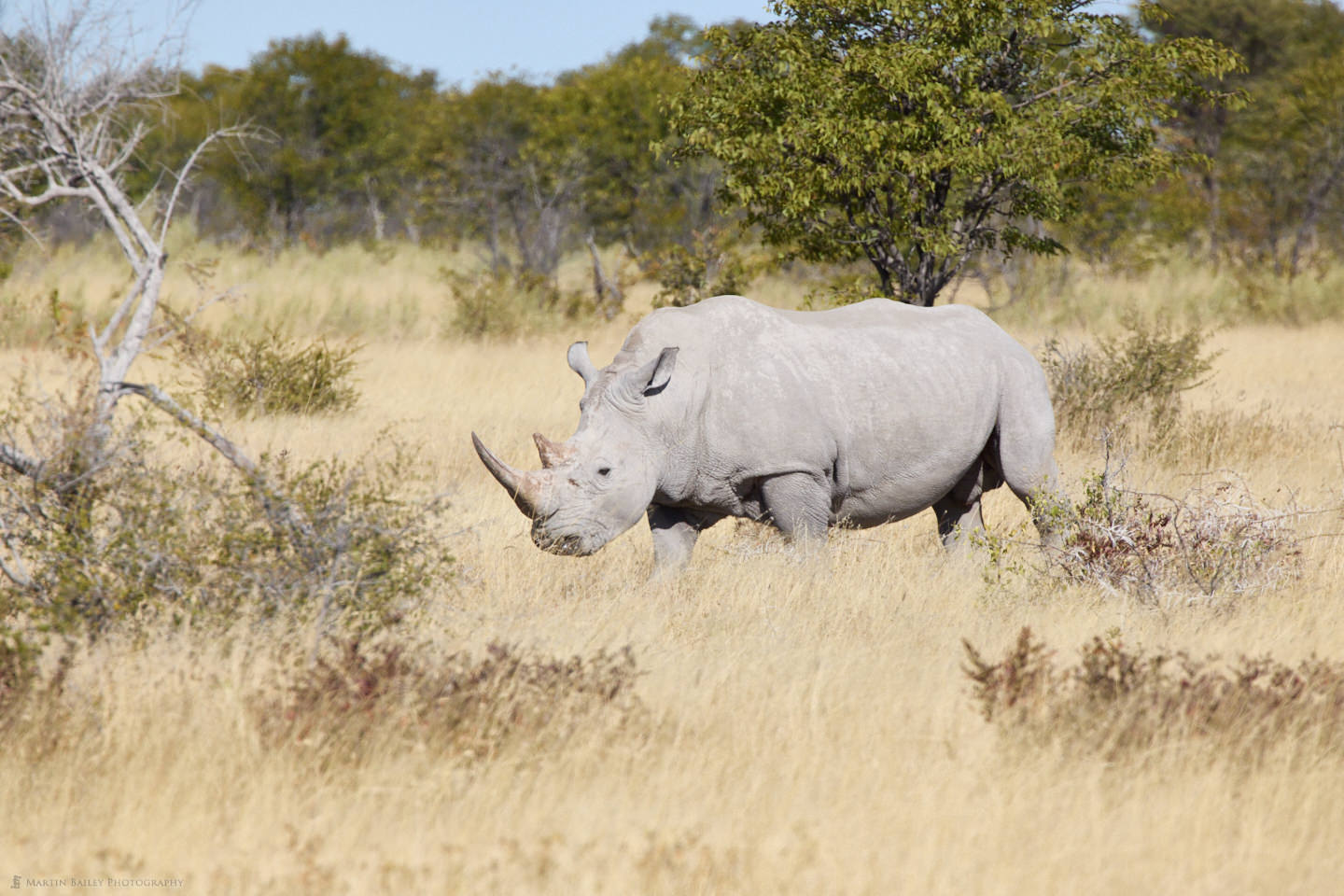
Again, I love the scene that this rhino is in with the beautiful tall yellow grass that simply could not grow for the few years before the pandemic struck due to the drought that lasted seven years, and ended finally with the rains that Namibia got in December and the start of this year. I used my 1.4X Extender on the 100-500mm lens for this shot, giving me a 700mm focal length. I haven’t called out the settings for all of my shots today, but generally, I am aiming to get a shutter speed of around 1/2000 of a second to freeze the motion should an animal be running around, and that requires an ISO of around 1600 at ƒ/11, or as in this case, ƒ/13 because I wanted slightly more depth of field to show the landscape in focus. Also, note that if you click on images on my website, you can see the shooting data in the light box surrounding the images if you are interested.
I was happy with this next photo of a Lilac-breasted Roller bird in flight, until I saw a shot from one of my guests with the wings spread and a beautiful angle showing the top of the bird. Now I’m not so impressed with my own shot, but it’s great to see my guests get incredible work, and it always helps me to stay on my toes as well.
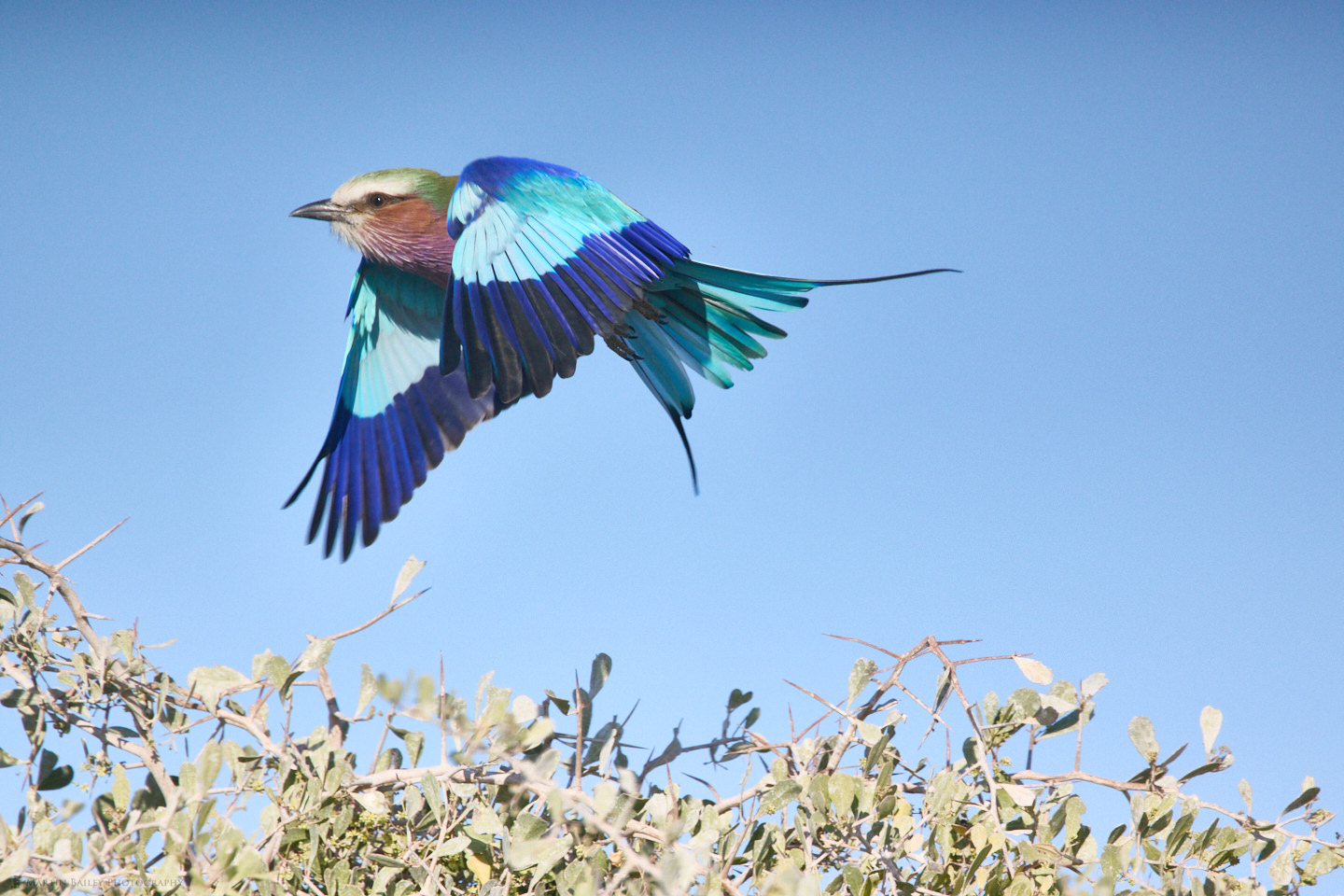
Again, I’m so impressed with the Canon RF 100-500mm lens, including with Extenders fitted, as it handles really well, and the image quality is out of this world. Being able to get out to 700mm with the 1.4X Extender is amazing, and I’ve gotten used to the fact that you can’t zoom out completely when you have an Extender fitted.
We don’t always need very long focal lengths, though. This beautiful, proud African elephant is pretty much filling the frame at 300mm. If I’m not mistaken, this is the one that shortly after this did a dummy charge at our vehicle as it walked in front of us. He wasn’t comfortable with the distance. He was so close that I’d switched to my iPhone to get some video, which I’ll include in the slideshow that I’m going to put together to showcase the trip after posting this concluding episode of my trip report series.
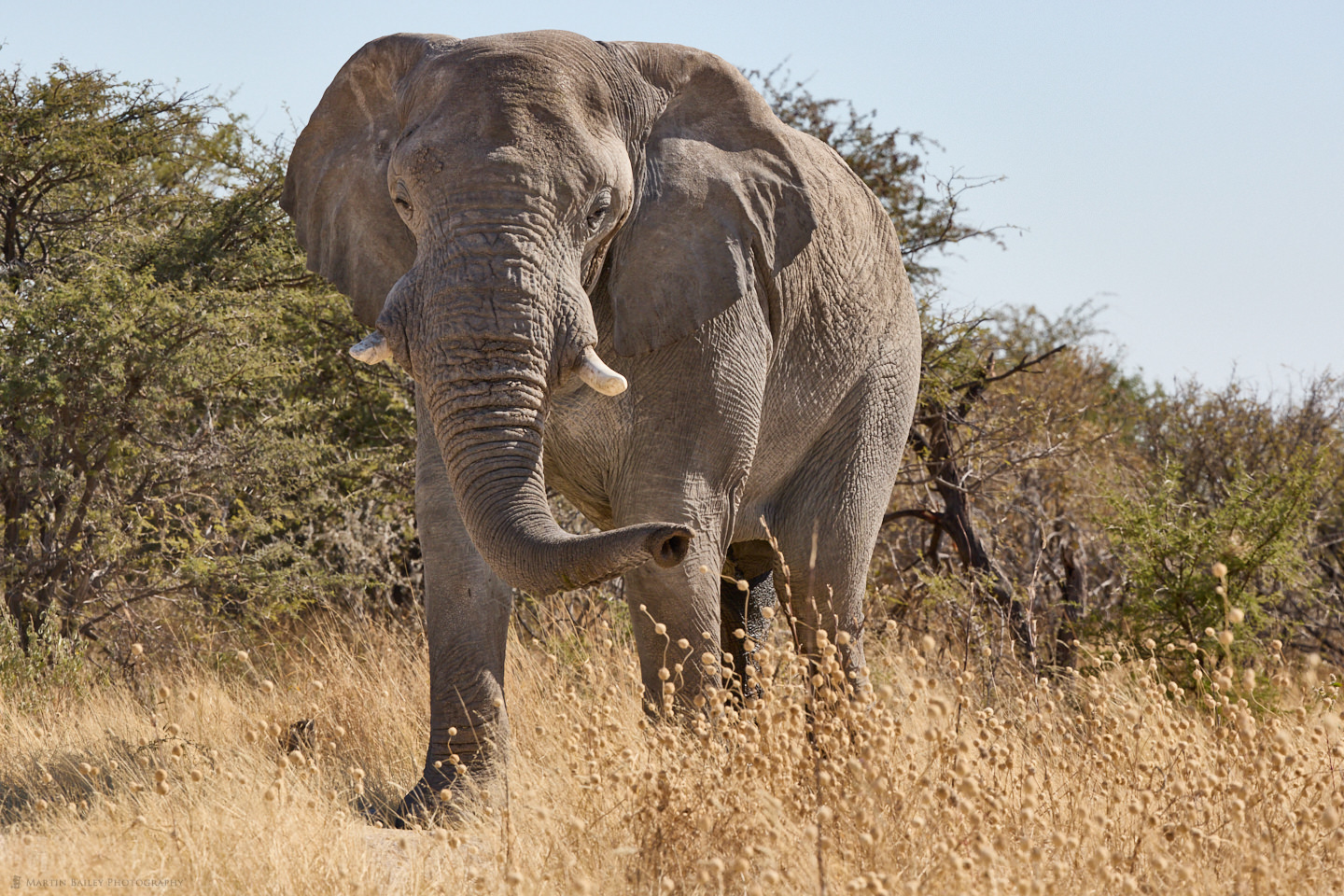
Next, we have a Journey of Giraffes, also shot relatively wide at only 223mm. I cropped this down to a panorama to emphasize the width of the group. We can tell from the pattern in their fur that these are Angolan Giraffe, and I also heard that the darker colored giraffe are the older animals.
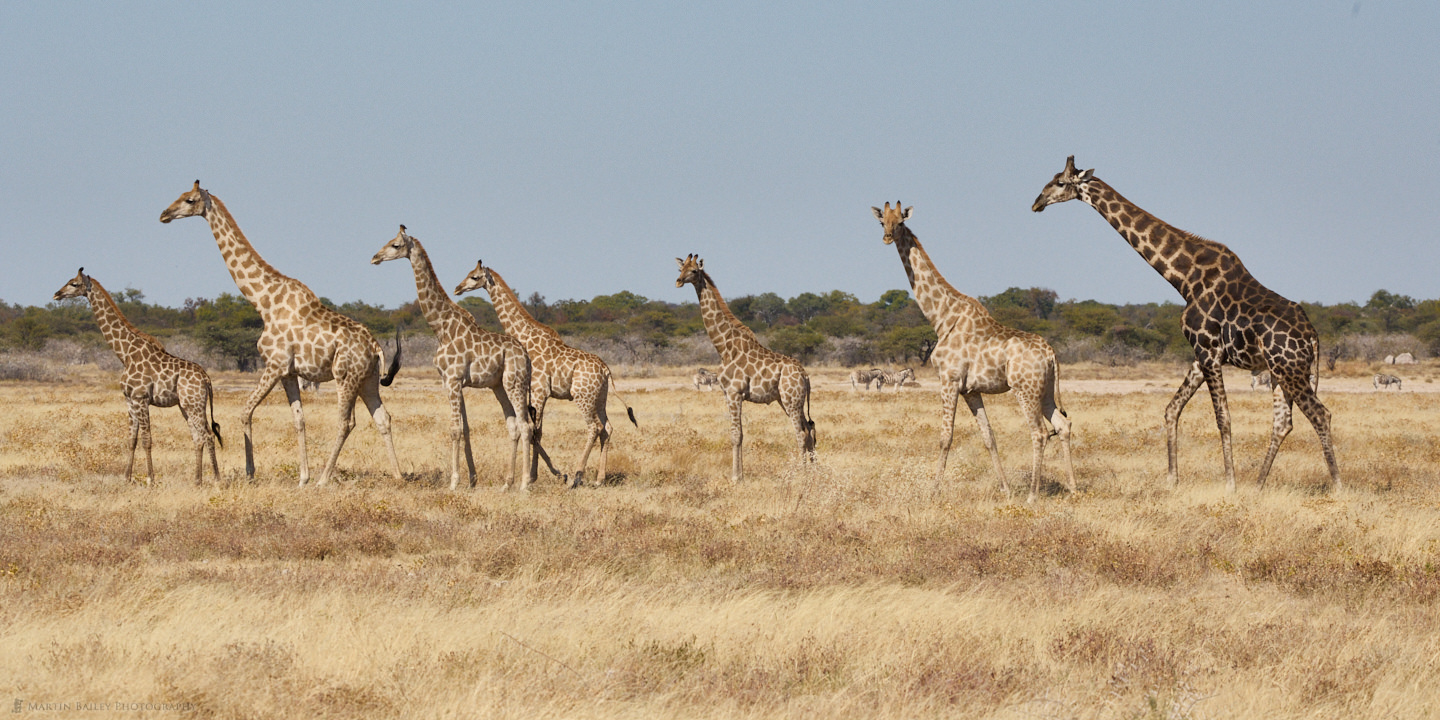
We also saw a lot of scuffles and fighting between the zebra near the waterholes. I’m guessing that this is because the rains have provided more food, and that probably has the female zebra thinking more about having young and that in turn is making the males more likely to fight to find their pecking order within their groups. I returned with lots of shots of the zebra fighting and kicking each other, but this is probably my favorite. However, it is a somewhat brutal attack on the middle zebra, as we can see from the white of his eye as he receives a particularly hard blow from both sides of his neck.

The fiftieth and final image of this five-part series is an attempt at a panning shot. We saw some giraffe that had been frightened by something and started running from the waterhole, so I selected a slow shutter speed of 1/80 of a second and tried to pan with the giraffe to make the background a little blurry. I succeeded to a degree, and feel that probably with this number of animals and the distance to them, this is probably about as much as I can expect to succeed at relatively easily. Next time I think I’ll try around a 1/50 or a 1/40 of a second, as I do for my panning bird shots. Even though the success rate will be lower, if I can pull it off, it will give very beautiful results.
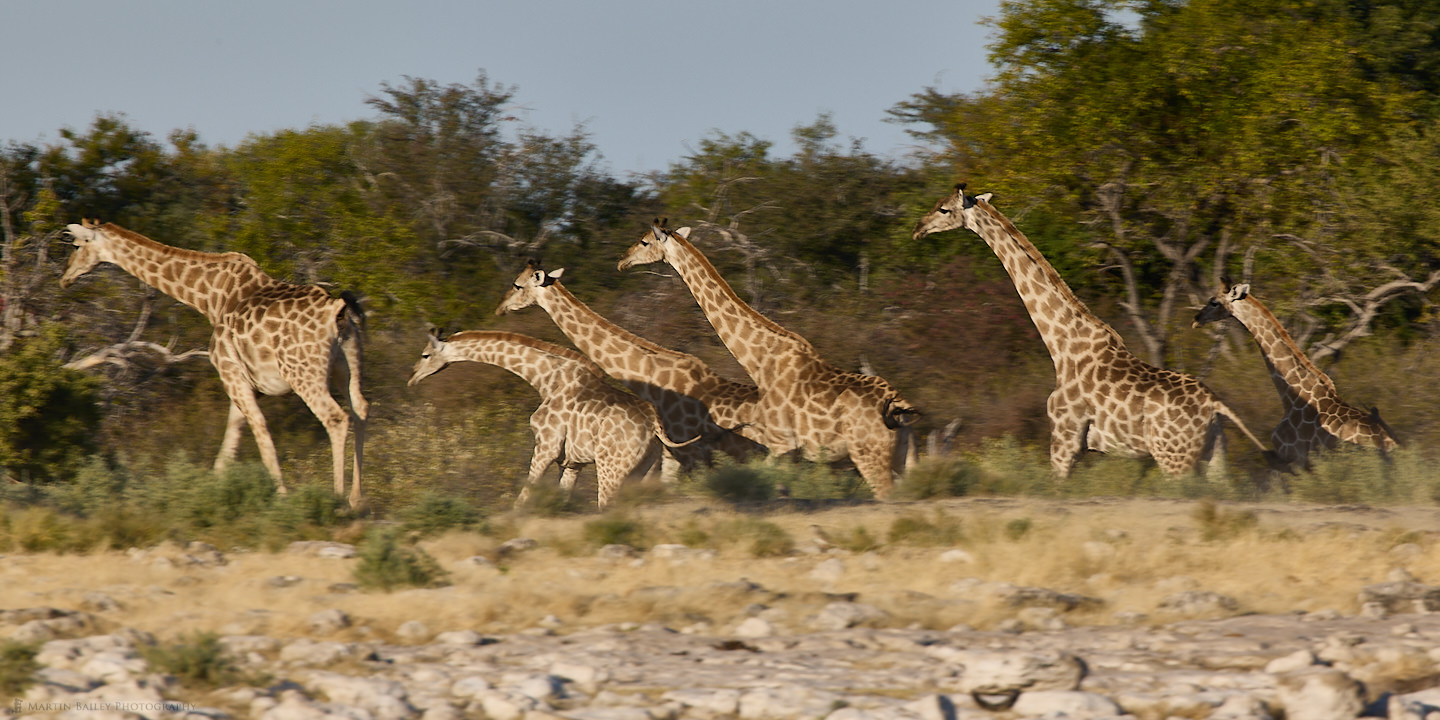
OK, so that’s about it for the images. We traveled back to Windhoek the following day, and before we all flew home, the group was kind enough to record a few comments for us, which I’ll add into the audio at this point.
<< PLEASE LISTEN TO THE AUDIO TO FIND OUT WHAT PEOPLE SAID >>
They were a wonderful group. Such a pleasure to travel with, and listening to them all again there made me feel as though we were still in Namibia four weeks ago, and in many ways, I wish we were. Life goes on here in Tokyo, though. Having thought about this often over the past six months, I’ve taken up archery since returning. I have joined a local club and enjoying it immensely. I don’t know how it will play into my photography, other than the fact that it’s getting me out and is more physical exercise than I expected it to be, but that is great because I’ve already started to lose a few pounds, so hopefully, this is something that I’ll be able to continue.
As I mentioned a few times during this series of trip reports, I will now set about the task of creating a slideshow to showcase the trip and what can be achieved on my tour. I hope to be able to share that with you in another week or so, alongside some tips on using the latest version of Boinx Software’s FotoMagico.
Show Notes
Check out our tours here: https://mbp.ac/tours
Subscribe in iTunes to get Podcasts delivered automatically to your computer.
Download this Podcast as an MP3 with Chapters.
Visit this page for help on how to view the images in MP3 files.


But Martin, what was the best gin this trip for the G&Ts? 🙂
Hi David!
I actually didn’t find the best G&T gin this time around. It is, of course, Tanqueray!
Regards,
Martin.